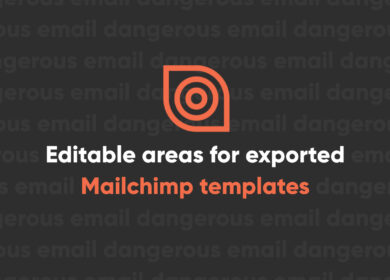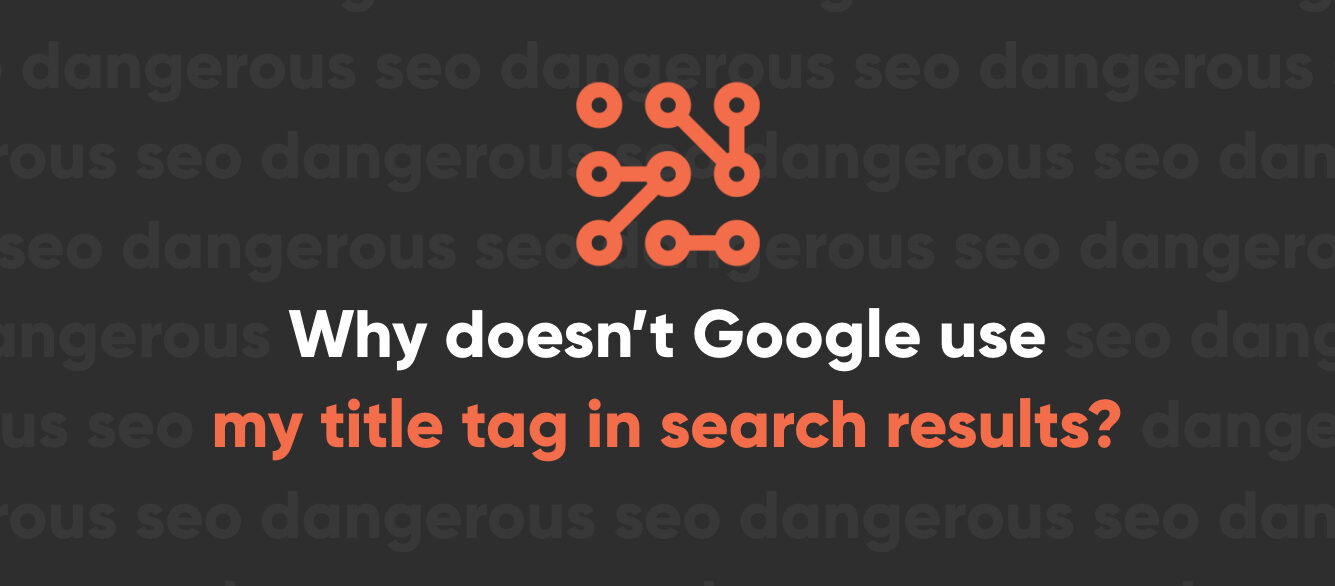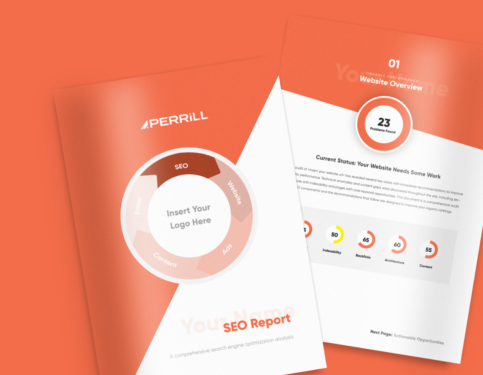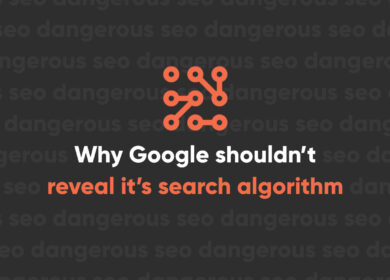
Why Doesn’t Google Use My Title Tag and Meta Description In Search Results?

If you know even a little about SEO, you know how important your page’s title tag is. Not only is it one of the top on-page ranking factors, but it’s also the first introduction that searchers have to your website. Get it right, and you’ll see throngs of new customers on your site. Get it wrong, and they’ll all flock to your competition.
So you spend hours upon hours optimizing those title tags and meta descriptions until you know they’re perfect. You force Google to recrawl your site so your updated titles and descriptions will show in the search results and help your click-through rates go through the roof. Then you search for your business only to find that Google has decided to use a different title and description. You panic. You know this is going to kill your business. What did you do wrong? Why is Google so evil?
Improve your search engine results
Title Tags, Meta Descriptions, and the Search Results
Before we get too far into the problem, let’s briefly review the title tag and the meta description. These are both elements you identify in the head of the HTML code of your page. Best practice is to have a unique title tag and meta description for every page on your site. A good title tag should accurately reflect what is on your page and stay close to Google’s pixel limits. A meta description should offer a glimpse of what your page is about and include a call to action.
There are many ways to implement a title tag and meta description, but the most common way to do it these days is by filling in a field in your content management system. Then these elements are automatically added to your HTML and ready for the search engines to read.
If you’ve properly filled in your title tag and meta description, then you’re essentially providing the search engines with a recommendation of what to display in the search results. Let’s take a look:

The above represents what Google is currently showing for the Perrill website when we do a search for "first scribe." Looks good, right?
But wait! That’s not our title tag! Our title tag is "Web Design Minneapolis, MN Web Development – Perrill." Google got it wrong!
Let’s compare Google’s version to what Bing shows:

Look, Bing got it exactly right! Google, on the other hand, has taken a small liberty here and flipped "Perrill" to the beginning of the title in the search results. Well, at least Google got the meta description right.
Why Google Sometimes Ignores Your Titles and Descriptions
Remember what we said before. The title tag and meta description are merely suggestions for what the search engines should display in the results. Google and Bing and other search engines are under no obligation to display exactly what you want them to display. In fact, in many cases, the search engines won’t display the title tag and meta description you specified.
This can be frustrating, but there is a purpose for it. It’s not that Google is evil or out to get you. Remember what Google’s ultimate goal is: to provide the most relevant search results possible for any given search query. Think about the example above. Why might Google put "Perrill" first? The answer should be pretty obvious in this case: that’s exactly what the searcher is looking for. It makes sense that Google did it that way.
Of course, this example isn’t really a big deal. After all, the end result is the same. Google is showing all the words we want in the order they want. As long as our click-throughs are high, we have no reason to be unhappy. But this is just a mild example. It’s often the case that Google will change your titles or descriptions completely, leaving you saying, "Hey, I don’t want Google to show that!"
Here’s another example. When I search for shoes, this is how DSW appears in the search results:

Seems decent, except the title tag for this page is Boots, Booties, Wedges, Pumps & Heels, Loafers, Sandals | DSW. The title tag contains every synonym for shoes, but it doesn’t contain the word "shoes" itself. And yet Google has changed the title in the search results. Why? The answer should be obvious. Google is trying to make the page seem more relevant to my search query. I wasn’t searching for boots or booties or wedges or loafers. I was searching for shoes. (What’s interesting here is that Google chose to show me Women’s shoes, but that’s another conversation entirely.)
There are many situations where the search engines won’t display your title tag or meta description. Here are a few potential scenarios:
- The title or meta description you specified isn’t relevant to the search query.
- The title or meta description you specified is too short or too long.
- The title or meta description you specified is not an accurate reflection of what your page is really about.
- There are multiple occurrences of a title or meta description specified in your HTML code.
- You haven’t specified a title or meta description.
- The search engine is ignoring your title or meta description and pulling information from elsewhere, such as Open Directory Project.
The Good News: You Do Have Some Control
All hope is not lost here. Your hours of work on those optimized title tags and meta descriptions are not necessarily for naught. In all the cases above except one, there are things you can do to improve the odds that Google will use your page title and meta description. Here they are:
- Make sure your title tag and meta description fall within Google’s length requirements. Since Google bases this on pixels rather than characters, it can be tough to determine exactly how long these elements should be. Best practice is to keep title tags around 60 characters and meta descriptions under 160. Update: As of December 2017, Google now shows up to 320 characters in search results. However, the search engine has not endorsed creating longer meta descriptions and has suggested that it is neither necessary nor recommended to increase the length of your meta descriptions to 320 characters.
- Make sure your title tag and meta description accurately reflect what’s on your page. Don’t stuff them with keywords you think you want to rank for. Instead, make sure that anything you put in your title and meta description is actually on your page.
- Make sure you only have one instance of title tag and meta description on your page. And make sure your syntax is correct. Don’t ever use <meta name="title">. That’s not a real thing. Your page title is whatever is between these tags: <title></title>. And your meta description is <meta name="description" content="insert meta description here" />. That’s it. Your CMS should automatically do this for you. If it doesn’t, you probably need a new CMS.
- Tell search engines not to use other directories to pull your information. This can be done with the simple command: <meta name="robots" content="noodp,noydir" />. This will prevent the search engines from using the Open Directory Project or Yahoo Directory as the basis for your title or description, making it more likely that they’ll use your title and description.
Unfortunately, there’s one thing you can’t always control: the relevance of your title and meta description to a specific search query. When the query doesn’t match the information you’ve provided, the search engines will change that information so your listing in the search results will seem more relevant. This often happens when someone searches for content that’s on one of your pages, but maybe it isn’t the "primary" content you’ve identified in the title and meta description.
While there’s no foolproof way to correct this problem, it may be worth it on your end to perform a content audit. If this is a common issue with your website, then maybe you need to build out new pages for certain topics on your site. For example, maybe you have one page that’s about both web design and ecommerce web development. This page is coming up when people search "ecommerce web development," but your title and description focus only on "web design." In this case, you’d probably be better off splitting this into two pages. Then you can specify a title tag and meta description for each page, and Google will be more likely to use what you want in the search results.
Of course, when it comes down to it, Google is displaying its own search results. That means you’ll never have full control over how your site appears in those search results. The best you can do is follow all best practices and provide the best user experience possible when those potential customers do click through to your site.
Do you need help with your SEO strategy? Contact the Minneapolis SEO experts at Perrill today.

Nate Tower
Nate Tower is the President of Perrill and has over 12 years of marketing and sales experience. During his career in digital marketing, Nate has demonstrated exceptional skills in strategic planning, creative ideation and execution. Nate's academic background includes a B.A. with a double major in English Language and Literature, Secondary Education, and a minor in Creative Writing from Washington University. He further expanded his expertise by completing the MBA Essentials program at Carlson Executive Education, University of Minnesota.
Nate holds multiple certifications from HubSpot and Google including Sales Hub Enterprise Implementation, Google Analytics for Power Users and Google Analytics 4. His unique blend of creative and analytical skills positions him as a leader in both the marketing and creative worlds. This, coupled with his passion for learning and educating, lends him the ability to make the complex accessible and the perplexing clear.




